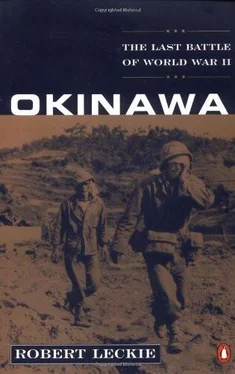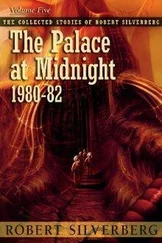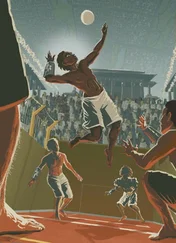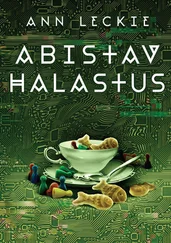The Sixth Marine Division was commanded by another Guadalcanal veteran: Major General Lemuel Shepherd, who would one day be commandant of the U.S. Marine Corps. His was an unblooded unit, sometimes called “the New Breed,” yet 70 percent of its men and officers were veterans of combat in orphan regiments that had been combined under the Sixth’s emblem of the silver Crusader’s Sword. Only two of its twelve rifle battalions had never known “the music” of bombs and bullets, and among its battle-wise veterans were Lieutenant Colonel Victor Kulak, a belligerent bantam called “the Brute,” the sarcastic nickname that Annapolis midshipmen pinned on all the coxswains of its rowing crews. In the ranks of this most gung ho of Marine divisions were such improbable swashbucklers as twenty-year-old Corporal Donald “Rusty” Golar, the self-styled Glory Kid. A brawny redhead, Rusty had fought with the Twenty-second Regiment on Guam and won a Bronze Star. “I’m a storybook Marine,” he would say, grinning when his buddies laughed outright. “I’m lookin’ for glory, and I’m lookin’ for Japs.” There were glory boys from collegiate football, too. Colonel Alan Shapley, commander of the Fourth Marines; had been one of the Naval Academy’s finest athletes. Lieutenant George Murphy of the Twenty-ninth Marines had been captain of the Notre Dame football team.
In General Geiger’s Third Corps reserve was the Second Marine Division. Its Second Marines had joined the original landing on Guadalcanal to be joined later by their comrades of the entire division. Derisively nicknamed “the Hollywood Marines” because they were based in California, they were not playacting when they waded ashore at Tarawa in 1943 to take in four days the island citadel that Rear Admiral Keiji Shibasaki had claimed could not be captured by “a million men in ten thousand years.” They went on to fight the grinding battle at Saipan in 1944. Major General Thomas Watson still commanded the Second. Because his Leathernecks had staged the eminently successful feint of the textbook shore-to-shore operation at Tinian, he had been asked to do it again at the Minatoga Beaches on Okinawa.
It was fitting that the commander of the Third Amphibious Corps, which included these three Marine divisions, should be Geiger, the gruff and grizzled white bear of a man more prone to deeds than words. Though a flying general, he had been in so many other invasions since Guadalcanal and had devoured so many textbooks on tactics that he had emerged as an excellent leader of ground troops as well.
Finally, Tenth Army’s Seventh Division—the Twenty-seventh Infantry commanded by Major General George Griner—was to be in “floating reserve” at Okinawa. If all went well there, the Twenty-seventh would occupy the island as a garrison division. For a division supposedly blooded in combat, such an assignment was not particularly dangerous, but the Twenty-seventh’s record in the Pacific had not been outstanding. A New York National Guard outfit, the Twenty-seventh saw its first action on Makin, where sixty-five hundred of its GIs landed on November 20, 1944. On the first night many of these half-trained guardsmen were panicked by Japanese scare tactics. Actually, the enemy numbered only five hundred lightly armed garrison soldiers holding paper-thin fortifications. But they held out for a week, though outnumbered thirteen to one and with almost no artillery to match the overwhelming American superiority in ordnance. During this delay the escort carrier Liscome Bay was sunk on the last day of battle, with a large loss of life. It was not the fault of the troops—it never is—for as Napoleon said: “There are no bad regiments, only bad colonels.”
Many of the Twenty-seventh’s officers from Major General Ralph Smith down to the lowliest second lieutenant were ineffective ; in fact, they were so indifferent to their responsibility that during maneuvers in Hawaii more than a few of them checked into Honolulu hotels for a night of revelry while their men slept on the bare ground. Again on Saipan under Smith the Twenty-seventh in between two Marine divisions moved so slowly that it lagged fifteen hundred yards behind these advancing formations. Thus a giant U was formed with the Twenty-seventh at the base, presenting the enemy with an unrivaled opportunity to exploit it. Immediately Marine Lieutenant General Holland M. “Howlin’ Mad” Smith, commander of the Fifth Corps, relieved Ralph Smith and replaced him with another Army general. This episode exploded with the loudest bang of the Pacific’s shameful Army-Navy rivalry. Prior to Saipan five Army generals had been relieved in the Pacific, but that had been by Army generals. For a Marine general to have the insolence to remove an Army general was to join cardinal sin to unforgivable insult. Actually, the Twenty-seventh improved after General Griner took command, and he was still in command at Okinawa, with many brave men eager to follow him and redeem their division’s honor—which they would do. The Twenty-seventh was not at full strength, only 16,143 men, compared to the 22,000 of the other Army divisions and the 24,000 for the Marines—which brought their replacements with them.
Altogether, General Buckner’s seven combat divisions numbered 183,000 men, of whom 154,000 would be in assault on the Hagushi Beaches—half again as many as Ushijima’s 110,000, although many of the Japanese commander’s troops were raw Okinawa conscripts. However, traditional military doctrine specifies that an attacking force, especially an invader from the sea, should possess at least a three-to-one superiority over the defense.
These, then, were the troops with which General Buckner intended to make rapid conquest of Okinawa, unaware that only at Peleliu had Americans encountered such a formidable fixed position. At Okinawa Ushijima commanded at least twenty times as many men and had fortified in depth ten times as many square miles. That Buckner was unaware of the grueling, step-by-step, shot-for-shot battle that awaited him was neither his nor his intelligence’s fault, for the winter and spring clouds that shielded the Great Loo Choo from the skies had made aerial pinpointing of enemy defenses extremely difficult, while the Japanese, unrivaled at camouflage, had so artfully concealed their caves and crevasses that a man might stand but a few paces from a 47 mm antitank gun and never notice it.
Because Imperial General Headquarters wanted to bleed the Americans white at Okinawa just as dearly as the United States Chiefs of Staff desired to seize it, Ushijima was prepared to sacrifice every man in his command to soak the soil of the Great Loo Choo in American blood.
In the wardrooms of the troop transports flowing up the curve of the world, nervous planners pored over maps and those skimpy aerial montages of enemy positions, some of them delighted that there seemed to be so few pillboxes and blockhouses, others, more practical—remembering Biak, Peleliu, and Iwo—scornfully exclaiming : “No resistance, huh? Wait till we get ashore!”
On the troop decks most of the conversation was about the deadly habu, a long, thick, dark snake whose bite was supposed to have no known remedy. Intelligence said the habu was something like a cobra, even displaying pictures of it. It was indeed a venomous-looking reptile, but in the lighthearted way of the American warrior, Buckner’s troops made jokes about it, and the habu soon passed into the immortal GI-Marine menagerie of the goony-birds of Midway, the upside-down pissing-possum of Guadalcanal, Australia’s lunatic-lunged kookaburra, the “beavers” of the North African beaches, the New Zealand kiwi, and the indecent snow-snake of Iceland. The men speculated so much about the habu that they almost forgot the Japanese, although officers frequently “held school” on the weather decks to stress the dangers of their objective.
Читать дальше










